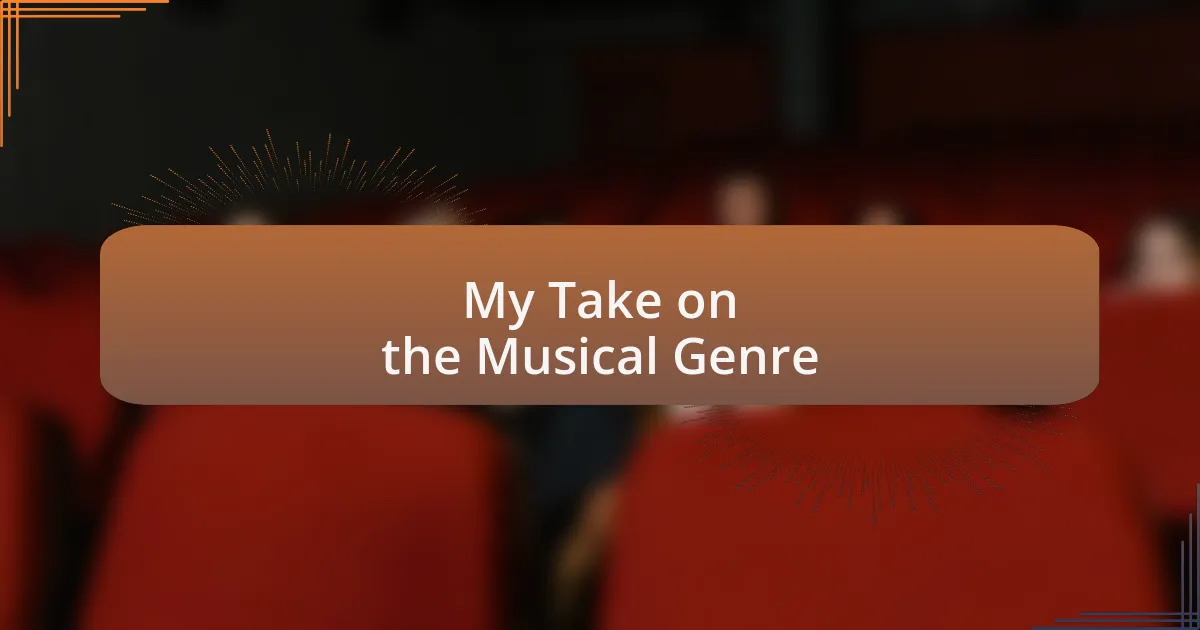Key takeaways:
- Musical genres in film evoke emotions and set the tone, significantly impacting the viewer’s experience.
- Distinct sounds, instrumentation, and lyrical content define genres, enhancing storytelling and evoking specific feelings.
- Music shapes film narratives by enhancing emotional resonance, guiding audience reactions, and framing character arcs.
- Carefully curated soundtracks can create immersive worlds, allowing viewers to escape reality and connect deeply with the narrative.
Author: Evelyn Hartwood
Bio: Evelyn Hartwood is a captivating storyteller and novelist known for her richly woven narratives and complex characters. With a passion for exploring the intertwining of human emotions and the natural world, her works often blend elements of magical realism with contemporary themes. A graduate of the Iowa Writers’ Workshop, Evelyn has published several acclaimed novels and short stories in prestigious literary magazines. When she’s not writing, she enjoys hiking in the mountains of her Pacific Northwest home and nurturing her garden. Evelyn continues to inspire readers with her unique voice and profound insights into the human experience.
Understanding musical genres in film
Musical genres in film serve as a powerful tool to evoke emotions and set the tone of a scene. I still remember watching a heartfelt drama where the score, a haunting blend of strings and piano, made my heart drop during a pivotal moment. Have you ever felt an inexplicable shiver when a particular melody played, gripping you tighter than the plot twist itself?
When we think of genres like jazz or funk in film, they often bring a unique energy that enriches the storytelling. I recall a quirky indie film that used a lively jazz soundtrack; it not only matched the characters’ vibrant personalities but also kept me smiling long after the credits rolled. Doesn’t it make you wonder how different a scene might feel if set against a classical score instead?
It’s fascinating how musical choices can sometimes define a genre of film altogether. For instance, the rhythms of hip-hop have been integral in defining the urban narrative in many indie films, capturing the essence of its culture and struggles. It poses the question: how might the emotional impact shift if the soundtrack were completely different? Ultimately, the music doesn’t just accompany the film; it collaborates with it, creating an immersive experience that resonates deeply with viewers.
Key characteristics of musical genres
Key characteristics of musical genres
Genres are differentiated by their distinct sounds and stylistic elements. For instance, the syncopated rhythms of reggae transport listeners to sun-soaked beaches and vibrant street parties, evoking feelings of relaxation and joy. I remember a scene from a film that utilized reggae to amplify its laid-back vibe, creating a mood that felt almost tangible. Have you ever found yourself swaying to the music, feeling like you were part of the scene?
Another key characteristic is instrumentation, which often sets genres apart. The twang of a banjo typically signifies bluegrass, instantly bringing to mind images of rural Americana. When I experienced a heartfelt indie film featuring impromptu bluegrass jams, it added authenticity to the narrative while making me feel nostalgia for simpler times. Doesn’t it strike you how certain instruments can evoke specific memories or emotions?
Finally, lyrical content can be profoundly impactful in shaping a film’s identity and emotional depth. For example, hip-hop lyrics often tell stories of struggle and resilience, making them especially powerful in character-driven narratives. Personal experiences with films that juxtaposed soaring orchestral scores with hard-hitting verses left me hooked, as the music echoed the characters’ journeys. Have you ever listened to a song that resonated so deeply with a character’s pain that it stayed with you long after the credits rolled?
How music shapes film narratives
Music plays a crucial role in shaping film narratives by enhancing emotional resonance and guiding audience reactions. I recall watching a poignant scene where a haunting violin score underscored a character’s moment of loss. The way that music swelled in those critical seconds amplified the heartbreak, making the experience feel profoundly personal. Can you remember a moment when a score made you feel emotions you didn’t realize were there?
Moreover, music can serve as a narrative device, framing character arcs and setting the story’s tone. I once saw an independent film that used an upbeat folk soundtrack to contrast its themes of disillusionment. This clever juxtaposition created a tension that lingered throughout the movie, inviting viewers to reflect on the disparity between the joyful notes and the character’s struggles. Isn’t it fascinating how a simple shift in sound can change your perception of a story?
Finally, sometimes, music creates an immersive world that allows viewers to escape reality. In one memorable indie film, the carefully curated soundtrack transported me to a bustling city, filled with vibrant life and energy. Each song felt like a character of its own, blending seamlessly into the narrative and inviting me to lose myself in that atmosphere. Have you ever felt that electrifying connection between music and setting in a film?
